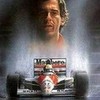hardingfv32 wrote:1) "No I meant the movement is independent of the suspension, and the suspension is in place to allow the movement which occurs besides track surface, the movement the chassis experiences because you are throwing it around corners."
How does the car's chassis movement improve cornering force? Weight transfer?
In a F1 car almost all of the weight transfer comes from the formula: weight transfer = weight x cg height / wheel track x g. Where do you plug in the chassis movement into the formula?
2) "Anyhow, the proposition is that a higher CoG (including rake) could generate more grip in the corners."
Weight transfer in the corners ALWAYS means reduced cornering force. Per the formula, a higher CG means more weight transfer.
Brian
Assuming track-surface grip is equal for everyne (same tarmeac and same tires - where rubber meets the road if you will) and that the moment you break out would be when the forces of weight tranfer are larger then the grip available that would lead to equal maximum weight transfer for everyone.
That would mean that the weight (car-weight + Downforce at speed x), CoG and wheelbase + wheel-track are determining figures. Things I would think that are missing is the radius of the CoG compared to the radius of the turn (ie centrally located weight vs more rearward).
With their, presumably, most efficient EBD, the RB7 would have more rear-ward biassed DF in turns compared to it's competitors given much betetr traction during mid-corner and corner exit where they can have more throttle opening in mid-corner and get earlier on full-throttle towards apex.
I think they need the FFW to counterbalance their rear DF at the back during the straights to avoid the nose being lifted to high killing their front-grip but also killing their diffuser efficiency.




